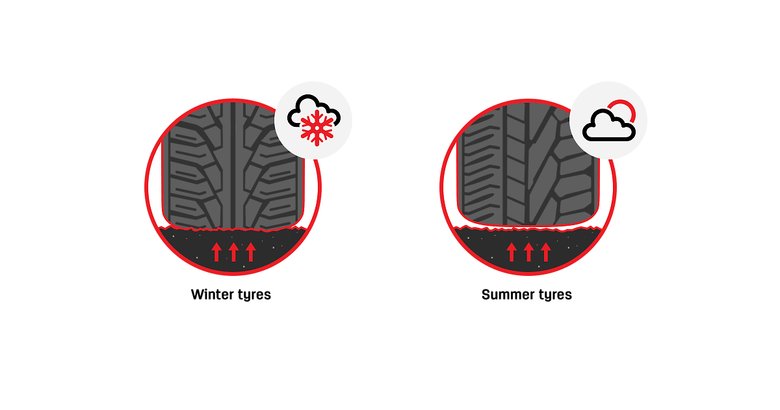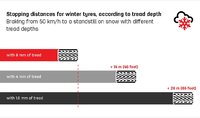What is the difference between summer and winter tyres?
For many people, particularly those living in countries with extreme weather, it is mandatory to have two sets of tyres – one for summer and one for winter. But what is the difference between summer and winter tyres?
Winter tyres
There are three fundamental differences between summer and winter tyres: their structure, their rubber compound and their tread pattern.
- Winter tyres have a higher natural rubber content which keeps them supple in the cold. The softer they are, the more the tyre is able to interlock with the road surface, improving grip and handling. Unlike summer tyres, which harden quickly in cold temperatures, winter tyres perform best in temperatures below +7 degrees C.
Winter tyres also have thousands of tiny grooves (known as sipes) in their tread blocks which are used to disperse water and prevent aquaplaning. These grooves bite into the snow, slush and ice, providing optimal grip with the road.
They also have a deep tread pattern. This provides a cavity for snow. Strangely, nothing grips snow better than snow, and the compacted snow intensifies the grip effect, adding traction to push the vehicle forwards on snowy and icy roads.
Difference:
Winter tyres perform best in temperatures below +7 degrees C.
Summer tyres perform best in temperatures above +7 degrees C.
How temperature affects winter and summer tyres?
You can spot a winter tyre because it features a ‘Snowflake on a Mountain’ symbol on its side wall, indicating that it satisfies the safety criteria for winter conditions.Another difference between winter tyres and summer tyres is that winter tyres should be replaced when their tread reaches a depth of 4mm whereas 3mm is the recommended minimum depth for summer tyres. As you will see from this diagram, stopping distance increase as tread depths decrease. So a new tyre, with 8mm tread, will stop faster than one with 4mm and considerably faster than one with only 1.6mm remaining. In fact, once the tread has worn down below 4mm, the benefits of the winter tyre have little or no effect on snow or ice.
Summer tyres
- Summer tyres provide better all-round performance in the warmer months. They have a relatively hard compound which softens in milder temperatures to be able to adapt to dry as well as wet roads.
- Summer tyres have fewer sipes than winter tyres, but have specially designed tread bars to minimise aquaplaning. These provide more grip both longitudinally and laterally in warm temperatures. ensuring lots of grip on wet and dry roads.
- Although summer tyres can handle most weather conditions, they’re not suitable for harsher, colder climates. They have a harder rubber compound with less natural rubber than winter tyres and this begins to harden and can become brittle below +7 degrees C. That said, they are designed to adapt to higher temperatures without getting soft. This means that summer tyres have lower friction and therefore are more fuel efficient.
Summer tyres tend to have a simple block-shaped tread pattern, providing a large footprint with the road. This ensures excellent handling and have a massive impact on the braking distance.
Source: Uniroyal







